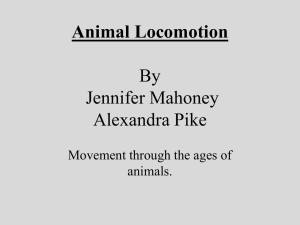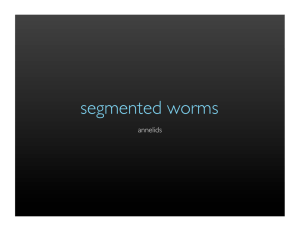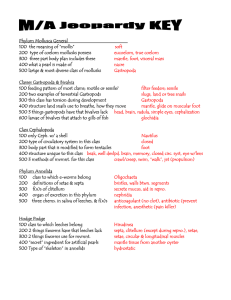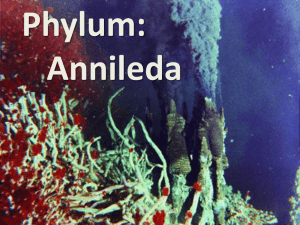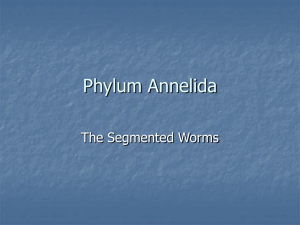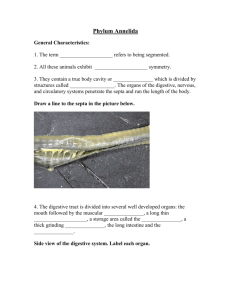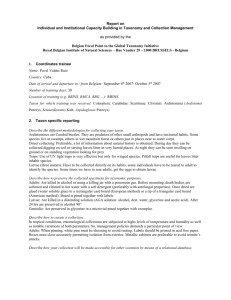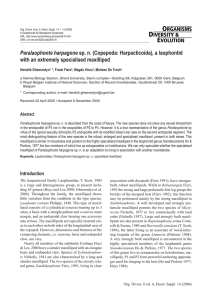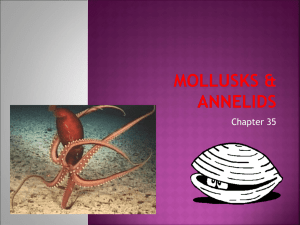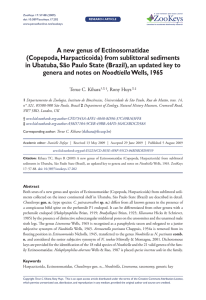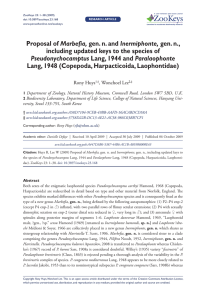On the junior subjective Coullia (Copepoda, Harpacticoida, Laophontidae): an update
advertisement
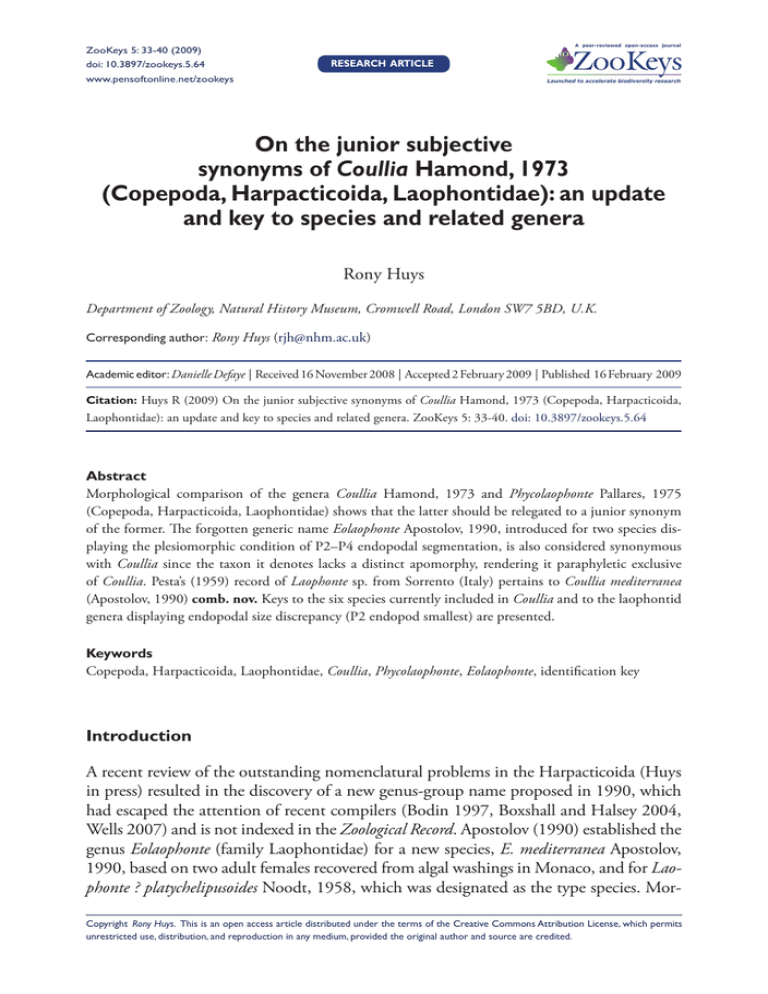
A peer-reviewed open-access journal ZooKeys 5: 33-40 (2009) On the junior subjective synonyms of Coullia Hamond, 1973: an update and key to species doi: 10.3897/zookeys.5.64 RESEARCH ARTICLE www.pensoftonline.net/zookeys 33 Launched to accelerate biodiversity research On the junior subjective synonyms of Coullia Hamond, 1973 (Copepoda, Harpacticoida, Laophontidae): an update and key to species and related genera Rony Huys Department of Zoology, Natural History Museum, Cromwell Road, London SW7 5BD, U.K. Corresponding author: Rony Huys (rjh@nhm.ac.uk) Academic editor: Danielle Defaye | Received 16 November 2008 | Accepted 2 February 2009 | Published 16 February 2009 Citation: Huys R (2009) On the junior subjective synonyms of Coullia Hamond, 1973 (Copepoda, Harpacticoida, Laophontidae): an update and key to species and related genera. ZooKeys 5: 33-40. doi: 10.3897/zookeys.5.64 Abstract Morphological comparison of the genera Coullia Hamond, 1973 and Phycolaophonte Pallares, 1975 (Copepoda, Harpacticoida, Laophontidae) shows that the latter should be relegated to a junior synonym of the former. The forgotten generic name Eolaophonte Apostolov, 1990, introduced for two species displaying the plesiomorphic condition of P2–P4 endopodal segmentation, is also considered synonymous with Coullia since the taxon it denotes lacks a distinct apomorphy, rendering it paraphyletic exclusive of Coullia. Pesta’s (1959) record of Laophonte sp. from Sorrento (Italy) pertains to Coullia mediterranea (Apostolov, 1990) comb. nov. Keys to the six species currently included in Coullia and to the laophontid genera displaying endopodal size discrepancy (P2 endopod smallest) are presented. Keywords Copepoda, Harpacticoida, Laophontidae, Coullia, Phycolaophonte, Eolaophonte, identification key Introduction A recent review of the outstanding nomenclatural problems in the Harpacticoida (Huys in press) resulted in the discovery of a new genus-group name proposed in 1990, which had escaped the attention of recent compilers (Bodin 1997, Boxshall and Halsey 2004, Wells 2007) and is not indexed in the Zoological Record. Apostolov (1990) established the genus Eolaophonte (family Laophontidae) for a new species, E. mediterranea Apostolov, 1990, based on two adult females recovered from algal washings in Monaco, and for Laophonte ? platychelipusoides Noodt, 1958, which was designated as the type species. MorCopyright Rony Huys. This is an open access article distributed under the terms of the Creative Commons Attribution License, which permits unrestricted use, distribution, and reproduction in any medium, provided the original author and source are credited. 34 Rony Huys / ZooKeys 5: 33-40 (2009) phological comparison provides compelling evidence that both Eolaophonte and Phycolaophonte Pallares, 1975 are junior subjective synonyms of Coullia Hamond, 1973. Results and discussion Noodt (1958) described Laophonte ? platychelipusoides based on a single female from Tenerife. He suspected a relationship with Lang’s (1948) inopinata-group in the genus Laophonte Philippi, 1840 but the lack of information on the male made him consider this assignment provisional and rank it instead as species incertae sedis in the Laophontidae. Noodt also claimed similarities with Hemilaophonte Jakubisiak, 1932 and remarked on the convergent swimming leg morphology in the genus Platychelipus Brady, 1880 (hence his choice of the specific name). Conversely, Lang (1965) believed L. ? platychelipusoides could be assigned to either Paralaophonte Lang, 1948 or Arenolaophonte Lang, 1965 but this suggestion was based solely on (unspecified) female characters. Hamond (1973) proposed the genus Coullia for a new deepwater species from the North Carolina continental shelf, C. heteropus Hamond, 1973 (also known from one female only), and assigned L. ? platychelipusoides to this genus. He considered Coullia unique in its morphology of P2–P4, having no inner setae on the exopods and, more significantly, reduced endopods with that of P2 being smaller than the others (in virtually all other Laophontidae with endopodal size discrepancy known at the time it was the P4 that was smallest). His claim that the absence of terminal setae on P2–P4 exp-3 is also a generic diagnostic is unfortunately based on an oversight; the inner apical setae are present but minute and often obscured by the large outer distal spines. It should be noted that the spelling platychelipusioides, first introduced by Lang (1965) and subsequently adopted by other authors (e.g. Hamond 1973, Fiers 1992a, Bodin 1997, Gómez and Boyko 2006), is to be considered an incorrect subsequent spelling (ICZN Art. 33.3). Apostolov (1990) used the endopodal segmentation of P2–P4 to restrict the generic concept of Coullia (to species exhibiting 1-segmented endopods) and to justify the proposal of his new genus Eolaophonte (species with 2-segmented endopods). To the latter he removed C. platychelipusoides, which he designated as the type species, and a new species E. mediterranea, from Monaco. In the former he grouped Coullia heteropus and Hemilaophonte clysmae Por & Marcus, 1973, originally described by Por and Marcus (1973) from the Suez Canal. Fiers (1992a), who, like other authors, was not aware of Apostolov’s (1990) paper, also removed H. clysmae to the genus Coullia. Comparison of Apostolov’s (1990) diagnoses shows that the only notable difference between Eolaophonte and Coullia is the plesiomorphic expression of the small proximal endopod segment in P2–P4 in the former, thus rendering Eolaophonte a paraphyletic taxon. Pending the discovery of apomorphic character states which may characterize the taxon, Eolaophonte must be relegated to a junior subjective synonym of Coullia. Pesta (1959) illustrated the P5 and caudal rami of a damaged female from a submarine cave near Sorrento (Italy), which he tentatively identified as Laophonte sp. Although he alluded to similarities with Laophonte inopinata T. Scott, 1892 in the caudal On the junior subjective synonyms of Coullia Hamond, 1973: an update and key to species 35 ramus, and to Heterolaophonte curvata (Douwe, 1929) in the P5, it is now more than conceivable that he was dealing with Eolaophonte (= Coullia) mediterranea. Gómez and Boyko (2006) admitted difficulties in maintaining Coullia and Phycolaophonte as distinct genera, and the combination of characters (i.e. shape and armature of caudal ramus and female P5, 6-segmented antennule, armature and shape of P2–P4) used by these authors to place their new species Phycolaophonte tongariki Gómez & Boyko, 2006 is not exclusive to the latter genus. Consequently, Phycolaophonte is here subsumed into the synonymy of Coullia since there is no fundamental difference between its type species P. insularis (and P. tongariki) and species previously assigned to Eolaophonte. Pallares (1975a) herself had already hinted at a relationship with Coullia heteropus. The genera Phycolaophonte, Eoalophonte and Coullia collectively represent a monophyletic lineage in which each of the three “genera” merely illustrate different stages in the gradual reduction in swimming leg setation and segmentation (Table 1). Other, as yet undescribed, species of Coullia have been reported in washings of Maja squinado (Herbst, 1788) from the Mediterranean and of unidentified decapods from the Eastern Pacific (Fiers 1991, 1992a), in washings of the algae Hypnea musciformis (Wulfen) and Gracilaria foliifera (Forsskål) in South Carolina (Coull et al. 1983) and in the ‘aufwuchs’ communities of marine macrophytes in New Zealand (Hicks 1977, Coull and Wells 1983). Coullia Hamond, 1973 Amended diagnosis. Laophontidae. Body fusiform. Integument of cephalothorax and body somites usually with minute spinules; posterior margins of somites spinulose. Rostrum partially delimited at base; broadly rounded, not prominent. Genital doublesomite ♀ with ventrolateral internal chitinous ribs marking original segmentation. Pleural extensions of ♀ abdominal somites small. Caudal ramus cylindrical, subrectangular and elongate; with 7 setae; setae IV and V well developed, fused at base, and with fracture plane; seta VI reduced, setiform. Anal operculum spinulose. Sexual dimorphism in antennule, P2–P3 exopod, P3 endopod, P5, P6 and in genital segmentation. Occasionally in P4 exopod. Antennule moderately slender and 6- or 7-segmented in ♀; 7-segmented and subchirocer with 2 segments distal to geniculation in ♂; segment 1 occasionally with small blunt process; with aesthetasc on segment 4 (♀) or 5 (♂) and as part of acrothek on apical segment; all segments usually with spinular ornamentation along posterior margin. Antenna with 4 setae on exopod; allobasis with abexopodal seta. Mandibular palp relatively short, 1-segmented; with 1 basal, 1 exopodal and 3 endopodal setae. Maxillule with defined exopod bearing 2 setae. Maxilla with 3 endites on syncoxa; endopod represented by 3 setae. Maxilliped elongate; syncoxa with 2 setae; basis usually with few spinules along palmar and outer margins; endopodal claw long and curved, with 1 accessory seta. Rony Huys / ZooKeys 5: 33-40 (2009) 36 P1 long, with very elongate coxa and basis; with 2-segmented exopod, exp-2 with 2–3 short and 2 geniculate setae; endopod stout, enp-1 without inner seta, enp-2 with minute seta and long strong claw. Swimming leg exopods 3-segmented; without inner setae in ♀ (except P2 exp-2 in C. tongariki); inner apical element of distal exopod segment vestigial (except P4 ♀ in C. insularis/tongariki). P2–P3 exopodal spines smooth or with minute ornamentation. P4 exopod smallest and squat; spines clearly pinnate. P2– P3 exp-2 (where known) with inner seta in ♂. P2–P4 endopods 1- or 2-segmented, occasionally absent in P2. P2 endopod smaller than those of P3–P4; if 2-segmented, inner distal corner of P2 enp-1 usually drawn out into tube-pore. P3 endopod ♂ 2-segmented with enp-2 extending into sharp, curved apophysis. Armature formula as follows: Exopod Endopod P2 0.0.023 [♂: 0.1.023] 0.020 or 010 or absent P3 0.0.023 [♂: 0.1.023] 0.0(1-2)(0-1) or 021 [♂: 0.020] P4 0.0.02(2-3) [♂: 0.1.022] 0.0(1-2)1 or 02(0-1) P5 ♀ large, with separate rami; exopod elongate-oval, reaching far beyond endopodal lobe, with 6 setae; endopodal lobe moderately developed, with 3–5 setae. Fifth pair of legs in ♂ not fused medially; baseoendopod free at base; endopodal lobe minute, with 2 long setae; exopod longer than wide, with 5 setae. P6 ♀ forming opercula closing off paired genital apertures, with 2 setae; P6 ♂ asymmetrical; membranous flaps with 2 setae. Copepodids IV–V with modified P4 in ♀ (cf. Fiers 1998). Marine; frequently on algae or decapods (Xanthidae, Majidae). Type species. Coullia heteropus Hamond, 1973 [by original designation]. Other species. Laophonte ? platychelipusoides Noodt, 1958 = C. platychelipusoides (Noodt, 1958); Hemilaophonte clysmae Por & Marcus, 1973 = C. clysmae (Por & Marcus, 1973); Phycolaophonte insularis Pallares, 1975 = C. insularis (Pallares, 1975) comb. nov.; Eolaophonte mediterranea Apostolov, 1990 = C. mediterranea (Apostolov, 1990) comb. nov.; Phycolaophonte tongariki Gómez & Boyko, 2006 = C. tongariki (Gómez & Boyko, 2006) comb. nov. Key to the species of Coullia Hamond, 1973 The key to species below should be used with caution since several, as yet undescribed, species are known to exist (Hicks 1977, Coull and Wells 1983, Coull et al. 1983, Fiers 1991, 1992a). Secondly, there is considerable confusion in the literature with regard to the exact setal formulae for the P2–P4 (particularly the endopods) as several minute elements have almost certainly been overlooked or tube-pores may have been misinterpreted as rudimentary setae. Finally, little is known about the sexual dimorphism On the junior subjective synonyms of Coullia Hamond, 1973: an update and key to species 37 expressed in the swimming legs since only the male of C. insularis has been formally described (Table 1). 1 – 2 – 3 – 4 – 5 – P2–P4 endopods 1-segmented or absent ..................................................... 2 P2–P4 endopods 2-segmented .................................................................... 3 P2 endopod absent; P3 endopod ♀ quadrate; P5 ♀ baseoendopod with 4 setae; caudal ramus nearly 2.5 times as long as wide ..................... C. clysmae P2 endopod 1-segmented; P3 endopod ♀ about 3 times as long as wide; P5 ♀ baseoendopod with 3 setae; caudal ramus 3 times as long as wide ............. .................................................................................................C. heteropus P1 exp-2 with 5 setae/spines; P4 exp-3 ♀ with very long inner apical seta .... ................................................................................................................... 4 P1 exp-2 with 4 setae/spines; P4 exp-3 ♀ with minute (or without) inner apical seta ........................................................................................................ 5 P2 exp-2 ♀ without inner seta, enp-2 as long as enp-1 ................................. ............................................................................... C. insularis comb. nov. P2 exp-2 ♀ with inner seta, enp-2 distinctly smaller than enp-1 ................... .............................................................................. C. tongariki comb. nov. Antennule ♀ 7-segmented; P5 ♀ baseoendopod with 5 setae ....................... ................................................................................... C. platychelipusoides Antennule ♀ 6-segmented; P5 ♀ baseoendopod with 4 setae ....................... ........................................................................C. mediterranea comb. nov. Additional notes. In addition to the type locality, Por and Marcus (1973) found C. clysmae also in algal washings at Port Taufiq, outside the Suez Canal (Gulf of Suez). Table 1. Armature formulae of Coullia species. The setal formulae of P2–P4 exp-3 have been corrected for the minute inner apical setae which may have been overlooked in some species [they are consistently present in detailed species descriptions (e.g. Mielke 1985, Gómez and Boyko 2006)]; it is possible that they are genuinely absent on P4 exp-3. P1 C. clysmae C. heteropus C. platychelipusoides C. mediterranea C. insularis C. tongariki a b ♀ ♀ ♀ ♀ ♀ ♂ ♀ exp-2 4 4 4 4 5 5 5 P2 P3 exp enp exp 0.0.023 absent 0.0.023 0.0.023 010 0.0.023 0.0.023 0.020 0.0.023 0.0.023 0.020 0.0.023 0.0.023 0.020 0.0.023 0.1.023 0.020 0.1.023 0.1.023 0.020 0.0.023 P4 enp exp 021a 0.0.022 021 0.0.022 0.021 0.0.022 0.010 0.0.022 0.021 0.0.023b 0.020 0.0.022 0.021 0.0.023 P5 enp 021a 020 0.011 0.021 0.021 0.021 0.021 exp 6 6 6 6 6 5 6 benp 4 3 5 4 5 2 5 Por and Marcus (1973) claimed P3–P4 endopods have 3 setae; their figure of the P3 (Fig. 39) is inconclusive in this respect and requires confirmation; the tiny element between the 2 setae in both P3 and P4 may represent the apical tube-pore found in most other species (see e.g. Mielke (1985) for P4). According to Pallares (1975a) some specimens have only 2 outer spines (as in the ♂). 38 Rony Huys / ZooKeys 5: 33-40 (2009) Fiers (1992a) noted that the text and figures describing the P2 and P3 are contradictory; Fig. 40 in reality illustrates the P2, not the P3, and vice versa. Coullia clysmae differs from its congeners in the complete absence of the P2 endopod; this character, and the loss of the outer spine on P1 exp-1 require confirmation. Pallares (1975a) described C. insularis from washings of Macrocystis pyrifera (L.) and Delesseriaceae (red algae) collected in Bahía Vancouver, Isla de los Estados (Argentina). In a subsequent paper, Pallares (1975b) recorded the species from the plankton surrounding Macrocystis beds and washings of various algae including Durvillea and Delesseriacea. Mielke (1985) added a second record from Maiquillahue, central Chile, and updated the description of the male. The only notable difference between the two populations is found in the caudal ramus which appears more slender, having concave margins and a shorter seta II (as long as seta I) in the Argentinian material. Mielke remarked that Pallares (1975a) had reversed the outer and inner margin of the caudal ramus in her text description. Pallares noted variability in the number of outer spines on P4 exp-3 in the ♀ (2 or 3) but not in the ♂ (2); if 3 spines is the normal condition it implies that the P4 exopod is sexually dimorphic in those species that have retained that number in the female. The sexual dimorphism on the exopods of P2–P3 (exp-2 with inner seta) is probably diagnostic for all species of the genus since it is also expressed to a certain extent in the related genera Robustunguis and Psammoplatypus (Lee and Huys 1999). Coullia mediterranea shares with C. clysmae the minute and unarmed proximal exopod segment of P1. It is unclear whether this indicates common ancestry or is merely the result of imperfect observation. Pesta’s (1959) record of this species is based on a single female abdomen found in a submarine cave in the Gulf of Sorrento (Italy). Pesta gave illustrations of the P5 and caudal rami. Based on the apically recurved caudal seta V he claimed a certain similarity with L. inopinata, a species not yet recorded from the Mediterranean, but also admitted that the difference in leg 5 setation probably indicated that the specimen collected was juvenile. The remaining three species (platychelipusoides, heteropus, tongariki) are known from their respective type localities (Tenerife, North Carolina, Easter Island) only. Noodt (1958) described the female antennule of C. platychelipusoides as indistinctly 8-segmented with a partial suture subdividing the apical segment, however, Lee and Huys (1999) reinterpreted or re-examined the 8-segmented condition reported for some species of Paralaophonte and Heteronychocamptus Lee & Huys, 1999 and concluded that the ancestral state for the family Laophontidae is 7-segmented. Coullia heteropus is thus far unique within the genus by the presence of only three elements on the female P5 baseoendopod. Hamond (1973) overlooked the minute inner distal seta on P2–P3 (and possibly P4) exp-3, and the pinnate ornamentation on the exopodal spines of P4. Key to laophontid genera with reduced P2 endopod There are no published descriptions of male Coullia [sensu Hamond (1973)], but referring to personal observations of several undescribed species of Coullia, Fiers On the junior subjective synonyms of Coullia Hamond, 1973: an update and key to species 39 (1992a) confirmed that the sexual dimorphism in the P3 endopod and the armature pattern in the male P5 are exactly the same as in Hemilaophonte and Phycolaophonte. Fiers (1992a–b), Lee and Huys (1999) and, more recently, Gómez and Boyko (2006), recognized a close relationship between Coullia, Phycolaophonte, Hemilaophonte, Robustunguis Fiers, 1992 and Psammoplatypus Lee & Huys, 1999, based on the reduced P2 endopod (smaller than P3 endopod), the swimming leg sexual dimorphism (P3 endopod ♂) and the ovate shape of the female P5 exopod. McCormack (2006) added a new genus Carraroenia McCormack, 2006 which appears to be most basal in this lineage. The five genera currently recognized in this lineage can be differentiated as follows: 1 – 2 3 – 4 – P1 excessively enlarged with arched claw; reaching to posterior end of caudal rami; equivalent to about two-thirds of body length ............... Robustunguis P1 not excessively enlarged ......................................................................... 2 P4 exp-2 with inner seta in both sexes; ♂ P3 endopod 3-segmented ........... 3 P4 exp-2 without inner seta in both sexes; ♂ P3 endopod 2-segmented ...... 4 P2 exp-2 with inner seta; P3 exp-3 with 6 setae/spines; P5 exopod ♀ with 6 elements....................................................................................Carraroenia P2 exp-2 without inner seta; P3 exp-3 with 5 setae/spines; P5 exopod ♀ with 4 elements..........................................................................Psammoplatypus P4 exopod 2-segmented ....................................................... Hemilaophonte P4 exopod 3-segmented ....................................................................Coullia References Apostolov A (1990) Quelques espèces de la famille Laophontidae T. Scott (Copépodes, Harpacticoïdes) de Monaco. Fragmenta balcanica 14: 163-177. Bodin P (1997) Catalogue of the new marine harpacticoid copepods (1997 edition). Documents de Travail, Institut royal des Sciences naturelles de Belgique 89: 1-304. Boxshall GA, Halsey SH (2004) An Introduction to Copepod Diversity. London: The Ray Society, London. Coull BC, Creed EL, Eskin RA, Montagna PA, Palmer MA, Wells JBJ (1983) Phytal meiofauna from the rocky intertidal at Murrells Inlet, South Carolina. Transactions of the American microscopical Society 102(4): 380-389. Coull BC, Wells JBJ (1983) Refuges from fish predation: experiments with phytal meiofauna from the New Zealand rocky intertidal. Ecology 64(6): 1599-1609. Fiers F (1991) Allocation of Laophonte trispinosa Sewell to Xanthilaophonte gen. nov. and the description of X. carcinicola spec. nov. (Harpacticoida: Laophontidae). Zoologische Mededelingen Leiden 65: 287-312. Fiers F (1992a) A redescription of Hemilaophonte janinae Jakubisiak (Copepoda, Harpacticoida), a laophontid living in the gill chambers of the common spider crab. Belgian Journal of Zoology 122(2): 211-222. 40 Rony Huys / ZooKeys 5: 33-40 (2009) Fiers F (1992b) Robustunguis gen. nov., a genus of decapod associated laophontids (Copepoda: Harpacticoida). Zoologische Mededelingen Leiden 66(28): 399-412. Fiers F (1998) Female leg 4 development in Laophontidae (Harpacticoida): a juvenile adaptation to precopulatory behaviour. In: Dahms H-U, Glatzel T, Hirche HJ, Schiel S, Schminke HK (Eds), Proceedings of the 6th International Conference on Copepoda. Journal of marine Systems 15: 41-51. Gómez S, Boyko CB (2006) On a small collection of harpacticoids from Easter Island: the family Laophontidae T. Scott (Crustacea: Copepoda: Harpacticoida). Zootaxa 1352: 3-70. Hamond R (1973) Some Laophontidae (Crustacea: Harpacticoida) from off North Carolina. Transactions of the American microscopical Society 92(1): 44-59. Hicks GRF (1977) Species composition and zoogeography of marine phytal harpacticoid copepods from Cook Strait, and their contribution to total phytal meiofauna. New Zealand Journal of marine and freshwater Research 11: 441-469. Huys R (in press) Unresolved cases of type fixation, synonymy and homonymy in harpacticoid copepod nomenclature (Crustacea: Copepoda). Zootaxa. Lang K (1965) Copepoda Harpacticoida from the Californian Pacific coast. Kungliga Svenska Vetenskapsakademiens Handlingar (4)10(2): 1-560. Lee W, Huys R (1999) Bathylaophonte gen. nov. from deep-sea hydrothermal vents and the polyphyly of Paronychocamptus Lang (Copepoda: Harpacticoida). Cahiers de Biologie marine 40: 293-328. McCormack E (2006) Carraroenia ruthae gen. et sp. nov. (Copepoda, Harpacticoida, Laophontidae) from maerl substrates of the Irish west coast. Zootaxa 1202: 39-52. Mielke W (1985) Interstitielle Copepoda aus dem zentralen Landesteil von Chile: Cylindropsyllidae, Laophontidae, Ancorabolidae. Microfauna marina 2: 181-270. Noodt W (1958) Die Copepoda Harpacticoidea des Brandungsstrandes von Teneriffa (Kanarische Inseln). Abhandlungen der Mathematisch-naturwissenschaftlichen Klasse. Akademie der Wissenschaften under der Literatur in Mainz 1958(2): 53-116. Pallares RE (1975a) Sobre un nuevo género de la familia Laophontidae. Contribución científica. Centro de Investigación de Biología Marina, Buenos Aires 93: 1-5. Pallares RE (1975b) Copépodos harpacticoides marinos de Tierra del Fuego (Argentina) 1. Isla de Los Estados. Contribución científica. Centro de Investigación de Biología Marina, Buenos Aires 122: 1-35. Pesta O (1959) Harpacticoiden (Crust. Copepoda) aus submarinen Höhlen und den benachbarten Litoralbezirken am Kap von Sorrent (Neapel). Ergebnisse der Österreichischen Tyrrhenia-Expedition 1952. Teil: VI. Pubblicazione della Stazione zoologica di Napoli 30(suppl.): 94-177. Por FD, Marcus A (1973) Copepoda Harpacticoida of the Suez Canal. In: Contributions to the knowledge of Suez Canal migration. Israel Journal of Zoology 21(3-4): 249-274. Wells JBJ (2007) An annotated checklist and keys to the species of Copepoda Harpacticoida (Crustacea). Zootaxa 1568: 1-872.

